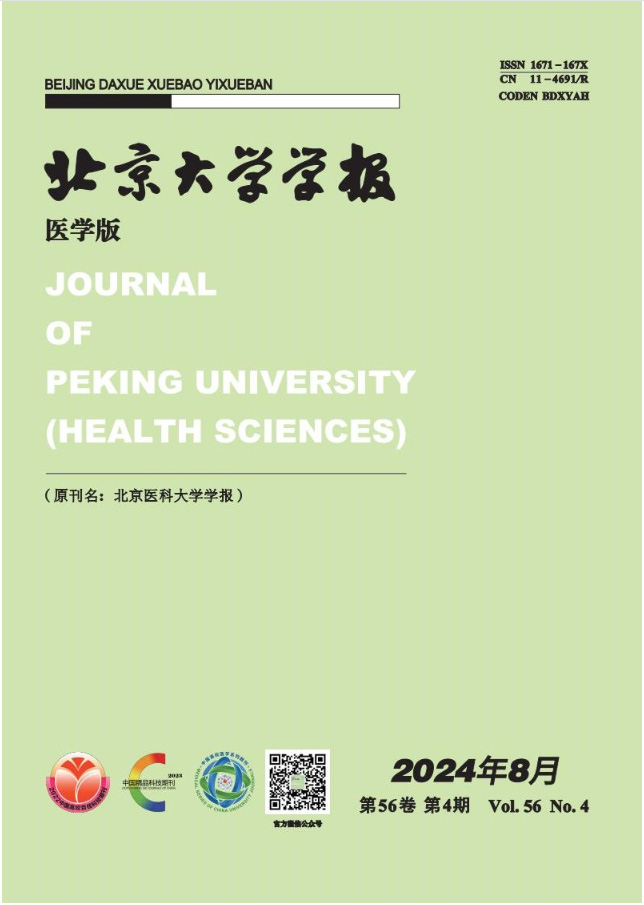[Sjögren疾病并发原发性乳腺淋巴瘤1例]。
摘要
本病例报告描述了一位67岁女性患者的诊断和治疗管理,她患有40年Sjögren疾病(SjD)病史,因持续一个多月的反复发热而住院。根据临床表现、血清学结果和腺体损害的证据,患者最初诊断为SjD是在40年前建立的。她的临床表现包括复发性腮腺肿大并伴有干燥症状,特别是持续性口干和干眼,随后出现进行性龋齿。血清学研究显示抗核抗体、抗ssa /Ro抗体和抗α-fodrin抗体阳性。客观评估证实明显的眼部受累(Schirmer试验≤5 mm/5 min)和胸部CT上肺间质改变,符合2016年美国风湿病学会和欧洲抗风湿病联盟(ACR/EULAR) SjD的分类标准。在低剂量皮质类固醇和改善疾病的抗风湿药(DMARDs)下,患者的病情保持稳定,直到最近开始持续发热,需要评估不明原因的发热。鉴别诊断考虑疾病爆发、感染和恶性肿瘤。欧洲Sjögren综合征疾病活动指数(ESSDAI)评分为5分,表明中度全身性疾病活动。初步实验室调查未发现感染证据,经验性抗感染治疗无效。值得注意的是,尽管没有淋巴结病变,但实验室结果包括IgM λ m蛋白阳性,乳酸脱氢酶升高,高铁蛋白血症和β2微球蛋白水平升高,考虑到SjD和淋巴瘤之间已建立的关联,这些结果引起了对淋巴增生性疾病的怀疑。骨髓穿刺未见明显异常,但PET/CT检查发现左乳房和右股骨远端高代谢病变,提示潜在恶性肿瘤。乳腺病变的后续组织病理学检查证实为非霍奇金淋巴瘤(NHL),特别是生发中心b细胞(GCB)亚型的弥漫性大b细胞淋巴瘤(DLBCL)。R-CHOP化疗(利妥昔单抗、环磷酰胺、阿霉素、长春新碱和强的松)在三个周期后诱导完全代谢缓解。然而,她随后出现了治疗相关的并发症,包括骨髓抑制和肺部感染。本病例强调了对SjD患者的非典型部位累及保持高度怀疑的重要性,特别是当淋巴瘤危险因素存在时。综合鉴别诊断应包括淋巴瘤和其他恶性肿瘤,并强调PET/CT和组织病理学检查在疾病评价中的诊断价值。SjD合并乳腺淋巴瘤极为罕见,其发病机制可能涉及淋巴细胞浸润、淋巴细胞异常活化、乳腺内异位生发中心的形成以及最终的恶性转化。这些机制需要通过临床和基础研究进一步研究。This case report describes the diagnostic and therapeutic management of a 67-year-old female with a 40-year history of Sjögren disease (SjD) who was hospitalized for evaluation of recurrent fever lasting over one month. The patient' s initial diagnosis of SjD was established four decades earlier based on clinical manifestations, serological findings, and evidence of glandular damage. Her clinical presentation included recurrent parotid gland enlargement accompanied by sicca symptoms, notably persistent xerostomia and xerophthalmia, followed by progressive dental caries. Serological studies demonstrated positivity for antinuclear antibodies, anti-SSA/Ro, and anti-α-fodrin antibodies. Objective assessments confirmed significant ocular involvement (Schirmer' s test ≤5 mm/5 min) and pulmonary interstitial changes on chest CT, consistent with the 2016 American College of Rheumatology and European League Against Rheumatism (ACR/EULAR) classification criteria for SjD. The patient' s condition remained stable under low-dose corticosteroids and disease-modifying anti-rheumatic drugs (DMARDs) until the recent onset of prolonged fever, necessitating evaluation for fever of unknown origin. Differential diagnoses considered disease flare, infection, and malignancy. The European Sjögren' s Syndrome Disease Activity Index (ESSDAI) score was 5 points, indicating moderate systemic disease activity. Initial laboratory investigations revealed no evidence of infection, and empirical anti-infective therapy proved ineffective. Notably, despite the absence of lymphadenopathy, laboratory findings including borderline positive IgM λ M-protein, elevated lactate dehydrogenase, hyperferritinemia, and increased β2-microglobulin levels raised suspicion for lymphoproliferative disorders, given the established association between SjD and lymphoma. Bone marrow aspiration showed no significant abnormalities, but PET/CT imaging detected hypermetabolic lesions in the left breast and right distal femur, suggesting potential malignancy. Subsequent histopathological examination of the breast lesion confirmed non-Hodgkin' s lymphoma (NHL), specifically diffuse large B-cell lymphoma (DLBCL) of the germinal center B-cell (GCB) subtype. Treatment with R-CHOP chemotherapy (rituximab, cyclophosphamide, doxorubicin, vincristine, and prednisone) induced complete metabolic remission after three cycles. However, she subsequently developed treatment-related complications, including myelosuppression and pulmonary infection. This case underscores the importance of maintaining a high index of suspicion for atypical site involvement in SjD patients, particularly when lymphoma risk factors are present. Comprehensive differential diagnosis should include lymphoma and other malignancies, and the diagnostic value of PET/CT and histopathological examination in disease evaluation is emphasized. SjD complicated by breast lymphoma is exceptionally rare, and its pathogenesis may involve lymphocytic infiltration, abnormal activation of lymphocytes, formation of ectopic germinal centers in the breast, and eventual malignant transformation. These mechanisms require further investigation through clinical and basic research studies.

 求助内容:
求助内容: 应助结果提醒方式:
应助结果提醒方式:


